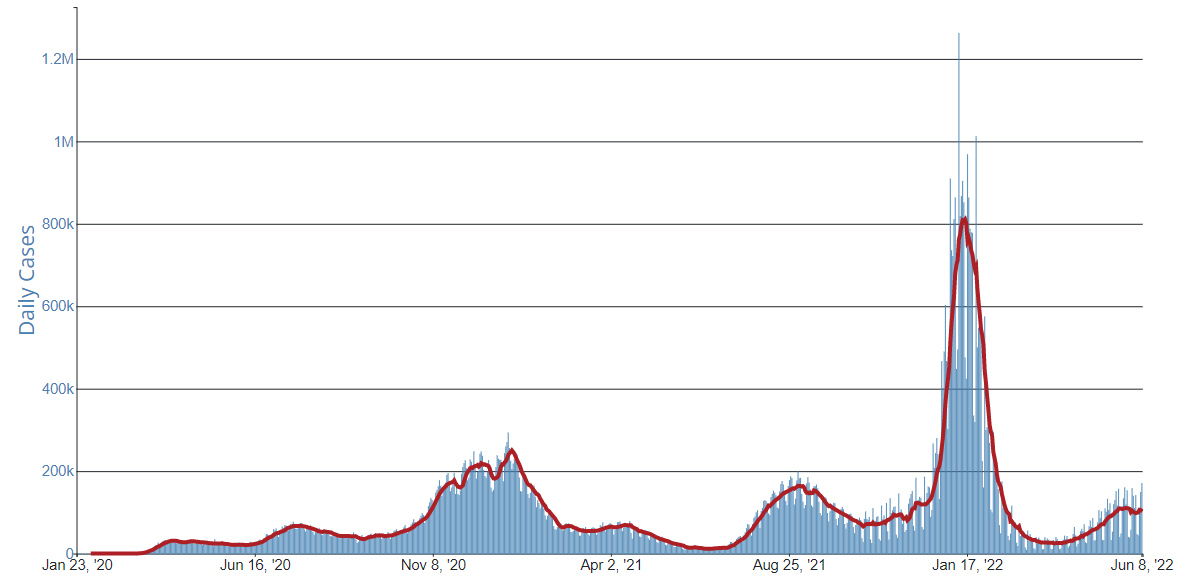Recommendations for Fully Vaccinated People
COVID-19 Homepage
Happy Campers
Interpretive Summary for June 10, 2022

Happy Campers
As we head into summer, many people are at much lower risk of serious illness, hospitalization, and death from COVID-19 because of increased immunity through vaccination or previous infection. Almost 71% of the U.S. population ages 5 years and older has completed their primary COVID-19 vaccine series, and treatments are widely available. While this is certainly good news, it is still important to protect yourself and others around you, including those who are at increased risk for severe illness.
CDC recently updated its guidance for K–12 schools and early care and education settings, which also applies to summer camps. Based on the COVID-19 Community Levels, this guidance gives schools and camps the flexibility to adapt to their changing local situations. It features a variety of strategies for keeping all kids safe, like promoting vaccination, offering testing, ensuring proper ventilation, and encouraging hand hygiene and mask-wearing. The guidance also provides advice on what to do if an outbreak occurs, regardless of community level. If you’re sending your kids to camp this summer, ask the camp director what steps they are taking to prevent COVID-19.
Make sure this summer is a safe one! Check your COVID-19 Community Level when planning activities, consider getting tested before you travel, and remember that being outdoors is safest. CDC recommends COVID-19 vaccines, including boosters, for everyone ages 5 years and older. Use CDC’s COVID-19 booster tool to learn if and when you can get boosters to stay up to date and protected with your COVID-19 vaccines.
Note to Readers: Learn more about COVID-19 vaccine recommendations for people who are moderately or severely immunocompromised.
- The Wastewater Surveillance tab now includes a national stacked bar chart showing how much virus levels have changed (increased and decreased) over time at wastewater sites across the United States.
- Ventilation Improvement Strategies Among K–12 Public Schools — The National School COVID-19 Prevention Study, United States, February 14–March 27, 2022
COVID-19 Community Levels
As of June 9, 2022, there are 314 (9.75%) counties, districts, or territories with a high COVID-19 Community Level, 1,052 (32.67%) counties with a medium Community Level, and 1,854 (57.58%) counties with a low Community Level. This represents a small (+2.20 percentage points) increase in the number of high-level counties, a moderate (+9.57 percentage points) increase in the number of medium-level counties, and a corresponding (−11.77 percentage points) decrease in the number of low-level counties. Fifty-two (100%) of 52 jurisdictions* had high- or medium-level counties this week.
To check your COVID-19 Community Level, visit COVID Data Tracker. To learn which prevention measures are recommended based on your COVID-19 Community Level, visit COVID-19 Community Level and COVID-19 Prevention.
*Includes the 50 states, the District of Columbia, and Puerto Rico.
Reported Cases
As of June 8, 2022, the current 7-day moving average of daily new cases (109,032) increased 8.0% compared with the previous 7-day moving average (100,916). A total of 85,084,715 COVID-19 cases have been reported in the United States as of June 8, 2022.
CDC Nowcast projections* for the week ending June 4, 2022, estimate the combined national proportion of lineages designated as Omicron to be 100%. There are several lineages of Omicron (B.1.1.529, BA.1, BA.2, BA.3, BA.4, and BA.5), and within each are multiple sublineages. COVID Data Tracker shows the proportions of Omicron lineages grouped as follows: B.1.1.529 (includes BA.1 and BA.3), BA.1.1**, BA.2, BA.2.12.1, BA.4, and BA.5. Previously, BA.4 and BA.5 were grouped with their parent lineage, BA.1.1.529, because the sublineages were circulating below 1%.
The predominant Omicron lineage in the United States is BA.2.12.1. The national proportion of BA.2.12.1 is projected to be 62.2% (95% PI 58.5-65.7%). The national proportion of BA.2 is projected to be 24.8% (95% PI 22.4-23.7%). BA.5 is projected to be 7.6% (95% PI 5.6-10.1%). BA.4 is projected to be 5.4% (95% PI 3.8-7.5%). Omicron is predicted to be 100% in all HHS regions.
85,084,715
Total Cases Reported
85,084,715
Total Cases Reported
109,032
Current 7-Day Average***
109,032
Current 7-Day Average***
100,916
Prior 7-Day Average
100,916
Prior 7-Day Average
8.0%
Change in 7-Day Average since Prior Week
8.0%
Change in 7-Day Average since Prior Week
*The median time from specimen collection to sequence data reporting is about 3 weeks. As a result, weighted estimates for the most recent few weeks may be unstable or unavailable. CDC’s Nowcast is a data projection tool that helps fill this gap by generating timely estimates of variant proportions for variants that are circulating in the United States. View Nowcast estimates on CDC’s COVID Data Tracker website on the Variant Proportions page.
**For national data, the proportion of BA.1.1 is shown separately. For regional data, the proportion of BA.1.1 is also aggregated with B.1.1.529.
***Historical cases are excluded from daily new cases and 7-day average calculations until they are incorporated into the dataset for the applicable date. Of 533,664 historical cases reported retroactively, 4 were reported in the current week and none were reported in the prior week.
Vaccinations
The U.S. COVID-19 Vaccination Program began December 14, 2020. As of June 8, 2022, 589.9 million vaccine doses have been administered in the United States. Overall, about 258.9 million people, or 78.0% of the total U.S. population, have received at least one dose of vaccine. About 221.6 million people, or 66.7% of the total U.S. population, have been fully vaccinated.* Of those fully vaccinated, about 104.1 million people have received a booster dose,** but 49.0% of the total booster-eligible population has not yet received a booster dose. As of June 8, 2022, the 7-day average number of administered vaccine doses reported (by date of CDC report) to CDC per day was 290,078, a 15.6% decrease from the previous week.
CDC’s COVID Data Tracker displays vaccination trends by age group, race/ethnicity, and urban/rural status. To see trends by age group and race/ethnicity, visit the Vaccination Demographic Trends tab. To see trends by urban/rural status, visit the COVID-19 Vaccination Equity tab.
589,852,206
Vaccine Doses Administered
589,852,206
Vaccine Doses Administered
258,881,611
People who received at least one dose
258,881,611
People who received at least one dose
221,567,092
People who are fully vaccinated*
221,567,092
People who are fully vaccinated*
78.0%
Percentage of the U.S. population that has received at least one dose
78.0%
Percentage of the U.S. population that has received at least one dose
66.7%
Percentage of the U.S. population that has been fully vaccinated*
66.7%
Percentage of the U.S. population that has been fully vaccinated*
+0.1
Percentage point increase from last week
+0.1
Percentage point increase from last week
+0.0
Percentage point change from last week
+0.0
Percentage point change from last week
*Represents the number of people who have received the second dose in a two-dose COVID-19 vaccine series (such as the Pfizer-BioNTech or Moderna vaccines) or one dose of the single-shot Johnson & Johnson’s Janssen vaccine.
**Represents the number of people who are fully vaccinated and have received another dose of COVID-19 vaccine since August 13, 2021. This includes people who received their first additional dose or booster dose.
Hospitalizations
New Hospital Admissions
The current 7-day daily average for June 1–7, 2022, was 4,127. This is an 8.0% increase from the prior 7-day average (3,820) from May 25–31, 2022.
4,774,751
Total New Admissions
4,774,751
Total New Admissions
4,127
Current 7-Day Average
4,127
Current 7-Day Average
3,820
Prior 7-Day Average
3,820
Prior 7-Day Average
+8.0%
Change in 7-Day Average
+8.0%
Change in 7-Day Average
The start of consistent reporting of hospital admissions data was August 1, 2020.
Daily Trends in Number of New COVID-19 Hospital Admissions in the United States

New admissions are pulled from a 10 am EDT snapshot of the HHS Unified Hospital Data – Analytic Dataset. Due to potential reporting delays, data from the most recent 7 days, as noted in the figure above with the grey bar, should be interpreted with caution. Small shifts in historic data may also occur due to changes in the Centers for Medicare & Medicaid Services (CMS) Provider of Services file, which is used to identify the cohort of included hospitals.
COVID-NET: Rates of COVID-19-Associated Hospitalizations among Children Ages 0-17 Years
CDC’s Coronavirus Disease 2019-Associated Hospitalization Surveillance Network (COVID-NET) shows that pediatric rates of COVID-19-associated hospitalizations remain highest among young children ages 0-4 years, who are not yet eligible for vaccination. Hospitalization rates among this age group are 2.5 per 100,000 population, compared to 0.8 and 1.5 per 100,000 population for children ages 5-11 years and 12-17 years, respectively, for the week ending May 21, 2022.
Rates of COVID-19-Associated Hospitalizations among Children Ages 0-17 Years

The Coronavirus Disease 2019 (COVID-19)-Associated Hospitalization Surveillance Network (COVID-NET) is an additional source for hospitalization data collected through a network of more than 250 acute-care hospitals in 14 states (representing ~10% of the U.S. population). Detailed data on patient demographics, including race/ethnicity, underlying medical conditions, medical interventions, and clinical outcomes, are collected using a standardized case reporting form.
Deaths
The current 7-day moving average of new deaths (306) has increased 18.6% compared with the previous 7-day moving average (258). As of June 8, 2022, a total of 1,005,823 COVID-19 deaths have been reported in the United States.
1,005,823
Total Deaths Reported
1,005,823
Total Deaths Reported
306
Current 7-Day Average*
306
Current 7-Day Average*
258
Prior 7-Day Average
258
Prior 7-Day Average
18.6%
Change in 7-Day Average Since Prior Week
18.6%
Change in 7-Day Average Since Prior Week
*Historical deaths are excluded from the daily new deaths and 7-day average calculations until they are incorporated into the dataset by their applicable date. Of 22,114 historical deaths reported retroactively, 409 were reported in the current week; and 133 were reported in the prior week.
Daily Trends in Number of COVID-19 Deaths in the United States Reported to CDC

7-Day moving average
 More Death Data
More Death DataTesting
The percentage of COVID-19 NAATs (nucleic acid amplification tests)* that are positive (percent positivity) is increasing in comparison to the previous week. The 7-day average of percent positivity from NAATs is now 13.7%. The 7-day average number of tests reported for May 27–June 2, 2022, was 476,710, down 26.7% from 650,347 for the prior 7 days.
896,910,194
Total Tests Reported
896,910,194
Total Tests Reported
476,710
7-Day Average Tests Reported
476,710
7-Day Average Tests Reported
13.7%
7-Day Average % Positivity
13.7%
7-Day Average % Positivity
13.3%
Previous 7-Day Average % Positivity
13.3%
Previous 7-Day Average % Positivity
+0.38
Percentage point change in 7-Day Average % Positivity since Prior Week
+0.38
Percentage point change in 7-Day Average % Positivity since Prior Week
*Test for SARS-CoV-2, the virus that causes COVID-19
Wastewater Surveillance
COVID Data Tracker’s Wastewater Surveillance tab tracks levels, changes, and detections of SARS-CoV-2* viral RNA in wastewater at over 900 testing sites across the country.
Currently, most of the country is reporting moderate SARS-CoV-2 levels in wastewater. Around 33% of sites are currently seeing some of the highest levels for those sites since December 1, 2021. Additionally, more than half of all sites reporting wastewater data are experiencing a modest increase in SARS-CoV-2 levels, but about 35 of sites are reporting a decrease in SARS-CoV-2 levels in wastewater. It is important to note that even a small increase when levels are low can appear like a dramatic increase in the percent change.
Last week, a Wastewater Metric Chart was added to COVID Data Tracker’s Wastewater Surveillance page. This chart shows how virus levels in wastewater have increased or decreased across the United States since January 2021. For more information on how to use wastewater data, visit CDC’s National Wastewater Surveillance System website.
*The virus that causes COVID-19
SARS-CoV-2 Levels in Wastewater by Site


0% means levels are the lowest they have been at the site; 100% means levels are the highest they have been at the site.





